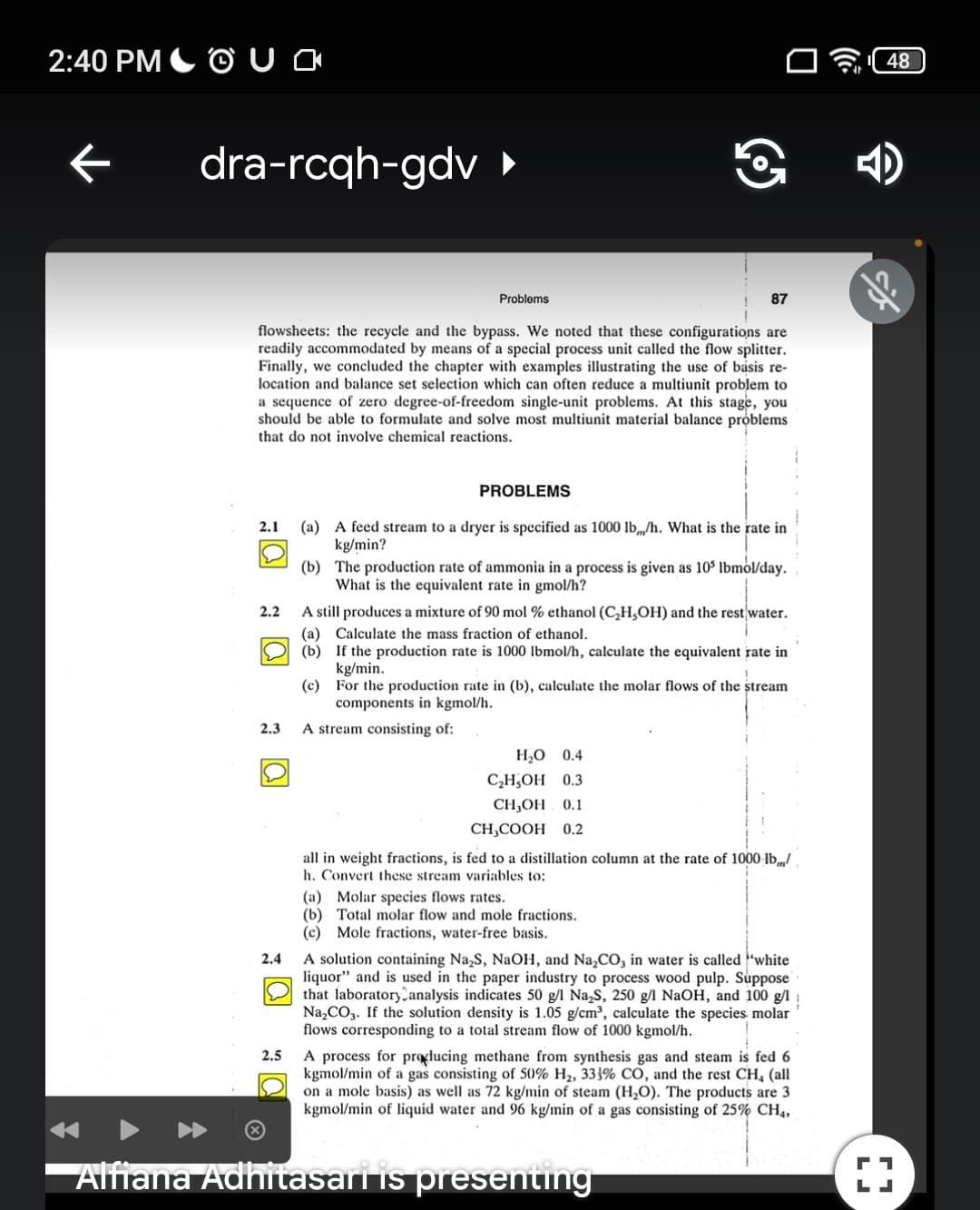2.1 (a) A feed stream to a dryer is specified as 1000 lb/h. What is the rate in kg/min? (b) The production rate of ammonia in a process is given as 105 lbmol/day. What is the equivalent rate in gmol/h?
2.1 (a) A feed stream to a dryer is specified as 1000 lb/h. What is the rate in kg/min? (b) The production rate of ammonia in a process is given as 105 lbmol/day. What is the equivalent rate in gmol/h?
Introduction to Chemical Engineering Thermodynamics
8th Edition
ISBN:9781259696527
Author:J.M. Smith Termodinamica en ingenieria quimica, Hendrick C Van Ness, Michael Abbott, Mark Swihart
Publisher:J.M. Smith Termodinamica en ingenieria quimica, Hendrick C Van Ness, Michael Abbott, Mark Swihart
Chapter1: Introduction
Section: Chapter Questions
Problem 1.1P
Related questions
Question

Transcribed Image Text:2:40 PM C O U a
48
dra-rcqh-gdv >
Problems
87
flowsheets: the recycle and the bypass. We noted that these configurations are
readily accommodated by means of a special process unit called the flow splitter.
Finally, we concluded the chapter with examples illustrating the use of basis re-
location and balance set selection which can often reduce a multiunit problem to
a sequence of zero degree-of-freedom single-unit problems. At this stage, you
should be able to formulate and solve most multiunit material balance problems
that do not involve chemical reactions.
PROBLEMS
(a) A feed stream to a dryer is specified as 1000 lb,„/h. What is the rate in
kg/min?
(b) The production rate of ammonia in a process is given as 10° lbmol/day.
What is the equivalent rate in gmol/h?
2.1
2.2
A still produces a mixture of 90 mol % ethanol (C,H,OH) and the rest water.
(a) Calculate the mass fraction of ethanol.
(b) If the production rate is 1000 lbmol/h, calculate the equivalent rate in
kg/min.
(c) For the production rate in (b), calculate the molar flows of the stream
components in kgmol/h.
2.3
A stream consisting of:
H,O 0.4
C;H¿OH 0.3
CH,ОН 0.1
CH,СOОH 0.2
all in weight fractions, is fed to a distillation column at the rate of 1000 lb/
h. Convert these stream variables to:
(a) Molar species flows rates.
(b) Total molar flow and mole fractions.
(c) Mole fractions, water-free basis.
A solution containing Na,S, NaOH, and Na,CO, in water is called "white
liquor" and is used in the paper industry to process wood pulp. Suppose
that laboratory analysis indicates 50 g/l Na,S, 250 g/l NaOH, and 100 g/1 !
Na,CO3. If the solution density is 1.05 g/cm³, calculate the species molar
flows corresponding to a total stream flow of 1000 kgmol/h.
2.4
A process for producing methane from synthesis gas and steam is fed 6
kgmol/min of a gas consisting of 50% H2, 33}% CO, and the rest CH, (all
on a mole basis) as well as 72 kg/min of steam (H,0). The products are 3
kgmol/min of liquid water and 96 kg/min of a gas consisting of 25% CH4,
2.5
Alfiana Adhitasari is presenting
Expert Solution
This question has been solved!
Explore an expertly crafted, step-by-step solution for a thorough understanding of key concepts.
Step by step
Solved in 3 steps

Recommended textbooks for you

Introduction to Chemical Engineering Thermodynami…
Chemical Engineering
ISBN:
9781259696527
Author:
J.M. Smith Termodinamica en ingenieria quimica, Hendrick C Van Ness, Michael Abbott, Mark Swihart
Publisher:
McGraw-Hill Education

Elementary Principles of Chemical Processes, Bind…
Chemical Engineering
ISBN:
9781118431221
Author:
Richard M. Felder, Ronald W. Rousseau, Lisa G. Bullard
Publisher:
WILEY

Elements of Chemical Reaction Engineering (5th Ed…
Chemical Engineering
ISBN:
9780133887518
Author:
H. Scott Fogler
Publisher:
Prentice Hall

Introduction to Chemical Engineering Thermodynami…
Chemical Engineering
ISBN:
9781259696527
Author:
J.M. Smith Termodinamica en ingenieria quimica, Hendrick C Van Ness, Michael Abbott, Mark Swihart
Publisher:
McGraw-Hill Education

Elementary Principles of Chemical Processes, Bind…
Chemical Engineering
ISBN:
9781118431221
Author:
Richard M. Felder, Ronald W. Rousseau, Lisa G. Bullard
Publisher:
WILEY

Elements of Chemical Reaction Engineering (5th Ed…
Chemical Engineering
ISBN:
9780133887518
Author:
H. Scott Fogler
Publisher:
Prentice Hall


Industrial Plastics: Theory and Applications
Chemical Engineering
ISBN:
9781285061238
Author:
Lokensgard, Erik
Publisher:
Delmar Cengage Learning

Unit Operations of Chemical Engineering
Chemical Engineering
ISBN:
9780072848236
Author:
Warren McCabe, Julian C. Smith, Peter Harriott
Publisher:
McGraw-Hill Companies, The